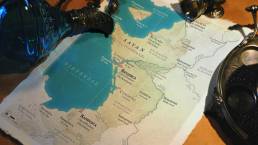
One of the most rewarding things about finishing my “Game Board” found-texture fantasy map earlier this year was the time I spent on world-building for toponymy. Creating fictional names for the places, cultures, and histories that populated my map ended up being inspiring both then and now. It grounded my fantasy world with stories and meaning it wouldn’t otherwise have, and made it much more approachable to other people. Since I use this fictional world for the table-top role-playing game I run, it’s important for it to feel real to my friends playing characters in this world.
Like all the creative work I’ve done there’s a method involved, so I’ll be able to keep doing it as much as I want or need to. It’s probably not as original as my found-texture cartography process, and I wouldn’t say this is how everyone should do it, but this is how I did it, and so far it’s worked very well. For me, creating unique fantasy place-names means striking a balance between familiar and foreign—to transport a viewer from the real world while keeping everything relatable enough to hold their interest and ideally inspire their imagination while they’re engaged with what I’ve made.
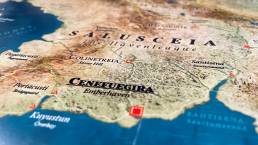
Object, Description, and Scope
I consider two things when creating names: a plain word for an object and a descriptive detail to modify that word. Many real-world place names do that, like Portland, and that’s also true for non-English names like Dublin (Black Pool), Montréal (Royal Mountain), or Shanghai (On the Sea). I usually start with words or phrases that describe natural features, cultural values, or historical events. I might focus on the physical landscape or weather conditions (local flora or crops, natural features like hills, landmarks like mines or farms, frequency of sunshine or storms). I could also memorialize individuals or ideas important to a society (influential people, religious beliefs, national origins), or commemorate major historical turning points (battles, discoveries, cultural achievements).
Another world-building consideration for names is scope: choosing to either start small and grow as you go, or go big right away and drill down as needed. For broader geographic areas or populations, you might choose more obvious names that convey general ideas or cover a larger area (like Scotland, “land of the Scots” or Norway “the way north”). For localities, you could focus on specific details that wouldn’t be confused with anywhere else (like San Francisco, “city of St. Francis”). For my map, I had to replace names from earlier versions of my project, because while those names sounded cool to me, they likely didn’t mean much to anyone else. To redevelop my map for a D&D campaign, I started with one settlement, so bigger-picture stuff like mythology, pantheons, or neighboring cities and countries took a back seat.
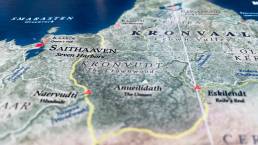
Welcome To Saithaaven (Seven Harbors)
I began with a city I’d called “Scarnasa” (a name with no meaning) slowly developing the place where my game would begin. Scarnasa was situated on a long channel between a lake and the sea. I’d already determined that my map’s distance scale made this a fairly large area, so I expanded this port settlement into a union with six other ports, and boom: “Seven Harbors” was born—a simple yet descriptive and memorable name. However, “Seven Harbors” isn’t this city’s only name (or even its main name) on the map, and “Scaransa” wouldn’t be totally gone either, because I wanted to get more creative. That’s where worldbuilding local culture comes in, which was manageable because I started simple.
“Starting simple” from a cultural standpoint, for me, meant starting with fantasy stories I knew and loved as a child, teen, and then young adult: hero myths about King Arthur and Merlin the Wizard, books like The Hobbit and A Song of Ice and Fire, and video games like The Legend of Zelda, Ultima: Quest of the Avatar, and Final Fantasy 1. Perhaps pretty standard and even clichéd, but still a valid starting point, and anyway I learned to subvert clichés later. My default setting inspiration was Western Europe, and (because one side of my family was once British) probably the British Isles. For my current D&D worldbuilding, I went back to that well of memories and placed Seven Harbors on my fantasy planet at about 50 degrees north latitude, which in Britain corresponded to Cornwall in the southwest.

I took cultural cues from Arthurian myths and the area’s real-world history for my game’s main conflict: Celtic Romano-British people fighting off the invading Teutonic Saxons. Those cultural names would have to change to make it even remotely original (more on that later too), but in terms of Seven Harbors’ name, I thought it was important to augment that accessible English name with an in-world, more fantastical name. That choice would help add some flavor to my real-world name, ideally melding two genre conventions: Tolkien’s high fantasy constructed-language for “Minas Tirith” with George R. R. Martin’s simpler, English-only “King’s Landing.”
The point isn’t to mash together ideas from two famous white men, though—it was combining the accessible with the unfamiliar, which my real-world atlases already did. A nation’s name appeared in its native language with the English version in parentheses below: ESPAÑA (Spain), EIRE (Ireland), or ELLAS (Greece). I chose that naming convention too, so my map shows SAITHAAVEN (Seven Harbors) where that fictional city stands. Why “Saithaaven?” I decided the region’s ruling culture would be a twist on the Arthurian-era Saxon conquest of Roman Britain—a Teutonic-like veneer spread over a deep and rich Celtic core. With the clumsy help of Google Translator and Thesaurus.com, I took the Danish words for “seven” and “harbor,” simplified the pronunciation, and came up with “Saithaaven.”
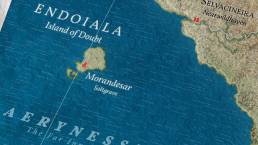
Get Personal and Have Fun (Welcome Back to Scarnasa)
Once I had a standard process in place, I tried plugging in different naming references and ideas just for fun. One huge fertile mental field was pulling place-names from my childhood in Orange County, California and repurposing them in fantastical ways. That brought in names like Crown Valley and Beacon Hill (a road and neighborhood) from Laguna Niguel, Three Arch Bay and Thousand Steps (a promontory and beach) from Laguna Beach, and Stonehill and Salt Creek (a road and waterway) from Dana Point. After deciding which fictional culture those places would be associated with, I put them through Google Translator (for Danish, Welsh, and Latin), simplified the results, and ended up with the nation of Kronvaal (Crown Valley), the fortresses of Bakenna (Beacon Hill), Trebarra (Three Arch Bay) and Suundas (Thousand Steps), the town of Colinetreia (Stone Hill), and the river Halenoc (Salt Creek).
One of my hobbies is listening to (and making) music, so another fun twist on “making it personal” was pulling names from real-world pop artists and songs. Again, once I chose which culture to attach, I ran an Uncle Tupelo song (“The Long Cut”), a Sting song (“The Wild Wild Sea”), an R.E.M. song (“Near Wild Heaven”) and a Talking Heads song (“The Creat Curve”) and lyric (“the island of doubt”) through the translator and pared down the results. That got me the Cimitarrae (Great Curve) Mountains, the Laangkudt (Long Cut) channel, the Vilanesse (Wild Sea), the town of Selvacinera (Nearwildhaven) and Endoiala (The Island of Doubt). A third method was using obviously real-world (or fictional-world) names—which worked because everything else was relatively original—so the fortress of Cuernacaba (Cape Horn) and the Acanthae (Spine) mountain range also showed up on my map. If George R. R. Martin can name his ancient river lords after Sesame Street characters (Kermit, Oscar, Elmo, and Grover Tully) then I can swipe Cape Horn.

I got really inspired when folding both of those twists back on the names I created with the first method and the original meaningless names I came up with years before. I used the Laangkudt name for the channel near Seven Harbors, and then thought “why would a natural feature have a name like ‘cut’ when ‘erode’ is a more ‘natural’-sounding process?” What if this massive, thirty-mile-channel really was “cut” in some human-made process? That’s a huge endeavor, so what if (because fantasy worlds can be magical) it was a supernatural effort by a more magical ancestry, like, say, elves? And so Seven Harbors acquired—or rather reacquired—the old “Scarnasa” name, which I thought might work in-world as Elvish for “Carved By Water.” In one fell swoop my fictional city now had a relatable real-world name, a current in-world fantastical name, and an in-world historical name that implied centuries of previous culture and habitation.
Don’t Stop Here, It’s Bat Country
Again, this isn’t the only way to do fantasy toponymy. It’s just what’s worked well for me and my bog-standard “medieval” fantasy project. It can work for any genre or any time period, and if you want to go gonzo it’s adaptable to anything else that grabs your attention. Stuck on a broad name for a huge region? Consider colors. Many real-world cultures associate colors with cardinal directions; in Eurasian cultures, maps sometimes show green (east), red (south), white (west), or black (north) arrows on their compasses or windroses to denote direction without words. Translating and transposing those names onto nations or continents is a snap.
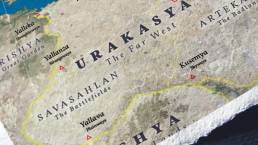
Hung up on history? I mentioned simplifying words as if the letters and sounds had blended together over time; ditching consonants and slurring vowels (among other things) is what transformed “Alexandria” into “Kandahar” in what’s now Afghanistan. Need lots of similar names for, say, a string of fortresses? Pick your culture, mash that translator button for “fortress,” “castle,” “stronghold” or “holdfast,” and play with the resulting word. Then use it as a prefix or suffix attached to unique descriptors. That’s how I came up with fourteen names for The Waycastles, outposts housing elite ranger and scout units who guard a dangerous frontier, and got inspired describing why they were important enough in their culture to influence the names of things—a great story prompt.
Remember, made-up words might sound cool, but they probably won’t mean anything to anyone but you, so dreaming up meanings for them will help you world-build histories, biographies, and other ideas for depth—adding insight to who lives in these places. The process might even help you expand to other aspects of world-building; Ursula LeGuin created an entire system of magic based on names. Fantasy maps risk meaninglessness without stories about their population. Every place becomes interesting when you can apply a world-building method to naming it. You don’t need to invent unpronounceable languages to do it, but you don’t need to stick to only real-world languages for the sake of accessibility—unless you want to! It’s your world, and you can change it.